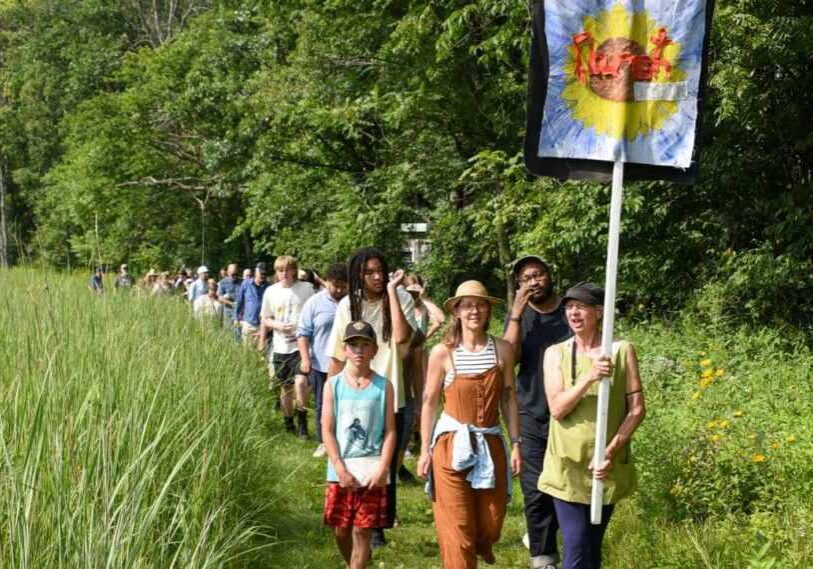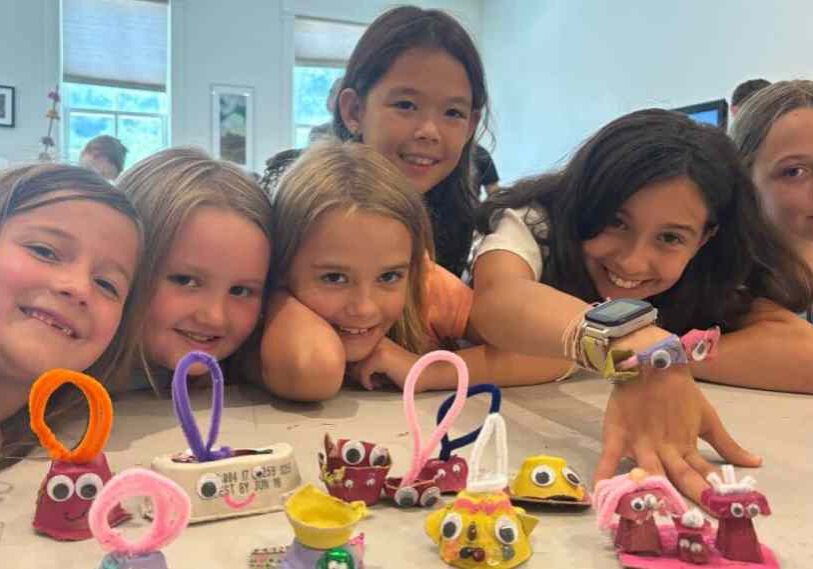Eagle Bluff’s Nature Preschool
A playful walk in the woods becomes a learning experience for preschoolers.

CARROLTON TOWNSHIP, FILLMORE COUNTY — On the north side of Eagle Bluff’s wooded campus is a dirt trail with a fallen log lying across it. To adult hikers, this low-lying obstacle provides a simple step-over, but to the children of Eagle Bluff’s Nature Preschool, it offers a creative challenge.
Some choose the classic hop over, a few hold hands as they take giant steps in unison, a couple venture the long way around. Others hug the log, pressing their bodies belly-down against the soggy wood, rolling neatly onto the other side.
There’s a cuteness factor in witnessing 15 young children in matching neon rain suits navigate downed trees, but as one of the educators, I see a teaching moment. Each child’s unique strategy demonstrates choice, focus, perseverance, and confidence. These are just some of the skills that are regularly fostered through the preschool’s mission: using environmental education to support the development of the whole child.
The kindergarten readiness program for ages 3-5 uses nature as the central focus to support learning and growth.
Nature preschools
Learning in nature is not a new concept in Minnesota. For centuries, Indigenous communities in the area have developed reciprocal relationships with the land and taught children skills, traditions, and ecological knowledge through direct experience. Since the introduction of colonial schooling systems, however, education has taken place inside buildings.
Today, students in the United States spend most, if not all, of their time indoors.

Preschoolers pause to observe fungus and moss growing on a dead log. (Photo by Clare Mazack)
One of the first re-integrations of nature into westernized schools was in the early 1900s, when the tuberculosis crisis spurred the open-air movement in Europe and the U.S. This encouraged some schools to function partially or completely outdoors. However, the impacts of this movement were complex, and defined by a health perspective, not specific educational pedagogies we see in current nature-based education.
The concept for nature preschools originated in the mid-20th century in Denmark. Ella Flautau and a group of parents held regular gatherings with their children in the woods and, after observing the growth spurred by these outings, organized “Walking Kindergartens.”
Educators in Germany followed suit, with their version – a “Waldkindergarten,” or “Forest Kindergarten” — designed for children to spend 70-100% of the time outdoors.
The U.S. saw its earliest versions of nature-based preschools in the 1960s, and the movement grew steadily starting in the 90s. In the last decade specifically, the number of nature preschools has grown exponentially – up to 250 by 2017 – as seen on this map!
While the specific pedagogy of nature-based programs is still being refined, early programs relied on education innovators including the inventor of kindergarten, Frederich Froebel, the inspiration for Waldorf schools, Rudolf Steiner, and renowned early childhood educator, Maria Montessori.
Current day programs carry various names and differentiate in the amount of time spent outdoors, but can be categorized into two groups:
The first type, Nature-Enhanced Early Childhood Education, features prominent outdoor experiences but is not built around nature. The second type, Nature-Based Early Childhood Education, includes forest kindergartens, nature preschools (such as Eagle Bluff’s Nature Preschool), and nature-based preschools. This second type of education model is based on four core components, reflected in the Principles of Eagle Bluff’s Nature Preschool:
- Nature is a central focus. Instructors “emphasize learning with nature rather than learning in or about.” There is no single guideline for the amount of time that must be spent outdoors for a preschool to be considered nature-based, but most programs have a minimum of 25 percent of time outdoors.
- Learning is child-led, play-based, and incorporates unstructured time. This means “teachers” are facilitators — they set boundaries for safe exploration, and spark curiosity through questioning. Materials and tools are provided to encourage individual play and cooperative role-playing.
- Development of the whole child is considered. This includes the physical, mental, social-emotional, and cognitive aspects of development, fostered through developmentally appropriate practices tailored to the age and needs of individuals.
- Education forms a lifelong connection to nature. There is a positive correlation between the amount of time children spend outdoors and the respect they feel for their environment. With continuous outdoor play, kids see themselves as a part of their surrounding natural landscapes, and are more likely to demonstrate care towards them.

Racing through the prairie during one of our daily hikes! (Photo by Clare Mazack)
Founded in 2020, our preschool is a unique partnership between Eagle Bluff and Semcac’s Head Start program. Ten spots are reserved for Head Start families and ten are available for open enrollment (with some scholarships provided).
This partnership works well as the core standards for Head Start align with some of the key goals of Nature-based programming and holistic development, investing in their physical, mental, cognitive, and social-emotional well-being.
The Nature Preschool is just one of Eagle Bluff’s programs that “connects people to nature and each other through transformative outdoor experiences.”
The year-round environmental learning center is most commonly known for its Outdoor School program that hosts students (primarily in grades 4-8) for overnight environmental field trips. The center also hosts public events, youth summer camps, and maintains year-round trails for everything from hiking to biking to snowshoeing.
Learning in nature through play
Like most preschools, each day is structured around a few daily necessities. We eat a family-style breakfast, brush our teeth, sing and dance along to songs during Morning Circle, and have free play where the children roam between various play areas.
After cleaning up, the children get dressed for the outdoor portion of their day. They layer on gear provided by the preschool: backpacks with full water bottles for warm days, matching blue snowsuits for winter months, brightly colored rain suits and boots for mud months.
The classroom’s back door opens up to a fenced-in play area that serves as the first stop in the journey outdoors. A wall of sandstone and limestone creates a boundary for the back half of the play area, cracked with winding fissures in a style familiar to frequenters of the Driftless region. The rock holds indents where tiny shovels and fingernails have scraped away at the surface, creating a living memory of previous mornings when the space operated as an ice cream shop, construction area, or a dinosaur graveyard.
Once the teaching team has gathered supplies, the hike begins! Preschoolers are kept in a “teacher sandwich” with a leading teacher, a roaming teacher in the middle, and another holding a boundary in the back. In this formation we can safely traverse throughout Eagle Bluff’s 250 acres of woods, prairie, ponds, wildlife, and the beloved Root River.
As outdoor educators, we plan relevant and seasonal activities for our time outdoors, but learning naturally happens along the way. In fall, leaves dance into outstretched hands. Children wonder at the giant puffball mushrooms lining the path, peer under rocks to greet the dirt-dwellers, and leave a trail of acorns behind them as their pockets overflow.
Winter offers handfuls of “snow snacks” and every hill becomes grounds for penguin-sliding, where the children glide belly-down amidst waves of giggles. The maintenance team plows snow into a high pile, creating a castle fondly referred to as “Mr. Marty’s Mountain.” Strength and patience allows their little bodies to climb up and slide down over and over again.
Spring brings mud, water, and baby green plants peeking out of the thawing earth. We wander off trail to find groups of fallen trees to dangle from, balance on, or duck beneath. Local maple trees, tapped by Eagle Bluff staff to create maple syrup, offer a scavenger hunt of metal buckets throughout the woods. We tap trees, watch the sap flow, and eventually witness a boil-off turn the sap to syrup. The preschoolers, of course, taste-test for ultimate quality-assurance.

One of the outdoor areas designed for the preschoolers. Logs are piled up around the perimeter to provide a natural border. It features a variety of nature-based structures and toys for the preschoolers to use. (Photo by Clare Mazack)
Daily hikes end at one of the two “Nature Playspace” areas designated for preschool use. Both spaces incorporate natural items into the design. A felled tree with a red slide attached to the end is intentionally placed to act as a balancing beam. A circle of stumps offers endless hopping opportunities. A mud kitchen, wooden boat, stick fort, play fire area, and lots of loose exploring tools inspire curiosity and creative role-playing.
The morning adventure wraps up at lunchtime, with a final hike up a hill to the building where we began. The day is finished with lunch, naptime, and story time.
Benefits of nature-based education
When we move the classroom outside and combine hands-on learning with play (and the opportunity to get dirty!), children start to see and understand the world around them in unique ways.
- They gain confidence in their abilities and how to identify their own limits. They realize they’re strong enough to climb up a brambly hill, slide down in the mud, and do it again 15 times. They know how to test conditions for safety and walk like a penguin if it’s icy or identify what parts of their body are fluctuating in temperature, if it’s cold.
- They learn cooperation and communication. In just one activity such as sledding, the kids will practice communication (“I’m coming down, please move!”), awareness (walking up the hill on the side), sharing (two per sled), and compassion (by checking in on friends who tumble).
- They learn to follow their curiosity. When there’s a natural fascination with acorns, we lean into it: collecting and hiding them to mimic a squirrel’s preparation for winter, getting up close to observe bite marks, making art out of them, leaving them in holes found in trees as a gift to the animals.
- Even traditional subjects like math and reading can be learned outdoors. Trees become a way to practice measuring by identifying how many preschoolers it takes to hug all around the trunk. Fallen sticks collected along the path become make-shift letters, alphabetizing the woods around us. We classify animal tracks, leaves, and mushrooms by colors, sizes, numbers, shapes.
Doruk Evcim, one of this year’s outdoor educators for the preschool, shares, “The biggest highlight for me is to see how far they come in one year. At the beginning, one of the children expressed being uncomfortable outside in any temperature and only wanted to swing in a hammock.
“Now she’s super willing to get dirty and snowy and is the first out the door,” Evcin says. “Perhaps best of all is witnessing the relationships they have built. It’s so heartwarming to see them all play together and enjoy each other’s company.”
Parents of preschoolers in the program notice changes too. They mention their kid’s moods are uplifted when they come home after preschool, and they are much more comfortable outdoors.
The most honest testimony, of course, comes from the children. Proclamations of “I did it myself!” and “I just love it here” illustrate their own lived experiences. The intentional time spent each day exploring the richness the natural world has to offer will impact them for years to come.






